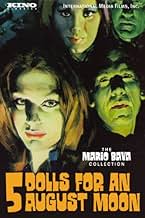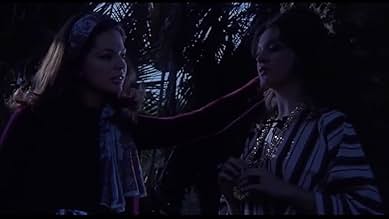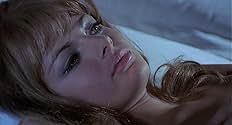एक उद्योगपति अपने सहयोगियों और उनकी पत्नियों को अपने निजी द्वीप पर छुट्टी के लिए आमंत्रित करता है ताकि वे एक मेहमान के क्रांतिकारी रेसिन फॉर्मूला के आर्थिक मूल्य का फायदा उठा सकें, लेकिन समू... सभी पढ़ेंएक उद्योगपति अपने सहयोगियों और उनकी पत्नियों को अपने निजी द्वीप पर छुट्टी के लिए आमंत्रित करता है ताकि वे एक मेहमान के क्रांतिकारी रेसिन फॉर्मूला के आर्थिक मूल्य का फायदा उठा सकें, लेकिन समूह के अन्दर एक कातिल उन्हें नाकाम कर देता है.एक उद्योगपति अपने सहयोगियों और उनकी पत्नियों को अपने निजी द्वीप पर छुट्टी के लिए आमंत्रित करता है ताकि वे एक मेहमान के क्रांतिकारी रेसिन फॉर्मूला के आर्थिक मूल्य का फायदा उठा सकें, लेकिन समूह के अन्दर एक कातिल उन्हें नाकाम कर देता है.
- निर्देशक
- लेखक
- स्टार
- पुरस्कार
- कुल 1 जीत
- Trudy Farrell
- (as Ira Furstenberg)
- Peggy Davidson
- (as Helena Ronée)
- George Stark
- (as Teodoro Corrá)
- Isabel
- (as Justine Gall)
फ़ीचर्ड समीक्षाएं
The general consensus seems to be that this is one of director Mario Bava's weakest efforts (even Bava himself was reportedly not fond of the film, being contractually obliged to direct); I can't really comment much on that since I've seen too few of his films to compare, but what I can say is that, even though I found the twists and turns of this Italian variation of Agatha Christie's Ten little Indians virtually impossible to fathom (especially the twist ending), there were still enough positives to make it worth a go.
As with many a giallo, the female cast are very easy on the eye, with genre regular Edwige Fenech stripping off whenever possible as always. There are numerous murders, and although they all occur off-screen (we get to see just the aftermath), the hanging up of the steadily growing number bodies in a meat locker is wonderfully macabre and darkly amusing. The jazzy score is super cool, perfectly complementing the wonderful '60s/'70s architecture and decor of the island's house. And despite Bava's purported disinterest, there is still an unmistakable sense of style, with effective uses of whip-pans and rapid zooms, and at least one stunning scene worthy of a genius, wherein a display of glass balls roll down a spiral staircase, along the floor, and into a bathtub where a woman has committed suicide.
All said and done, if this is his worst, I really must check out his best.
The opening starts like a fairy tale – albeit a very 1970s Italian one. Isabel (Justine Gall) prances through the woods like Carroll's Alice and comes to a house. Through the window she watches a forbidden party taking place. It appears that she witnesses a ritual murder – except it turns out to be a game.
But then a real corpse is found and the real game begins. On a remote island populated by self-interested, alcoholic, amoral millionaires ("Filthy swine from the same mould!"), everyone is a suspect.
The chief one initially is George (Teodoro Corra). He's brought a bunch of smug gits to the house to hammer out a business deal. They're all vying to purchase a secret scientific formula from Professor Fritz (William Berger). So when the professor cops it, the accusations start to fly and tensions start to fray. The bodies pile up quicker than you can say "Dario Argento".
Five Dolls wasn't a big release at the time and it's not a classic movie by any means (Bava himself disregarded it), but it's solid and reasonably tense. Naturally, once the murders begin everyone behaves like cogs in a movie narrative machine rather than a convincing human being, but that's par for the course. This is virtually a tech demo for Bava's craft – he's the Hitchcock of Italian cinema, as his choices of shots, focus, and fluid camera shifts show. And if nothing else you have a fantastic, unique jazzy score from Piero Umiliani, who even gives the bodies in the freezer their own jaunty piano theme.
Murder mystery fans will be frustrated by the film's pace, which sometimes gives us literally seconds between homicides. We're furnished with few clues to play with and the final twist is a dirty cheat. But let's not pretend there's no pleasure in watching these sharks eat each other; we're here to find out which of them makes it out alive, period.
Five Dolls is drenched in atmosphere and the production design gives a wonderful sense of the otherworldly – we could be on an alien planet. Silly and sexy, it's not an essential movie, but if you're interested in a macabre and hallucinatory curio from one of horror's most influential artists, look no further.
It has the breezy atmosphere that many late 60's Italian thrillers have. It wasn't until after Dario Argento's The Bird with the Crystal Plumage became an international success that the giallo genre became more direct, aggressively suspenseful and violent. Five Dolls is very much a product of the gialli that came before this. Its lounge music soundtrack and languid nature testify to this. As an actual mystery thriller it's pretty lacking it has to be said. It feels like Bava's contempt for the material is reflected in his complete indifference in creating a suspenseful or thrilling movie. While it's a whodunit with quite a number of murders, they are all committed off-screen. This is not to the film's advantage at all. Characters suddenly die from out of nowhere with no build up. Sometimes it feels like Five Dolls is a lampoon of the genre. Judging by the black humour Bava utilised in the following year's Bay of Blood it is entirely possible that he isn't taking things entirely seriously here either.
What Five Dolls does have though is a beautiful look and feel. This is hardly surprising I suppose seeing as its Bava's trademark. The cinematography is always interesting, with several well composed shots and good use of the beach-front location and villa. While the production design, fashions and cool décor are all appealing. The interest of the film, therefore, is more in watching a chic melodrama involving a group of largely unsympathetic rich people. It works better as this, than as a thriller. Still, it does have some nice macabre touches that would have graced his best films, such as the repeat scene of the murder victims hanging up in the freezer wrapped in plastic; or the shot of crystal balls rolling en mass down a set of stairs and into a bathroom leading us to yet another dead body. But perhaps best of all is the opening party scene which introduces all of the characters. It's campy to the max, with lots of slow zooms into all of the character's faces, while Fenech dances in a crazy sensual way. This sequence, like many others, benefits from the score by Piero Umiliani. It's a very eccentric soundtrack of organ-driven Italo-pop. Five Dolls is certainly a film that favours style over substance.
Five Dolls for an August Moon is not one of Mario Bava's best films but it is among his most charming. Despite the inherent weakness of its plot and mystery-thriller elements there's just something extremely likable about it. It's of its time in the best possible sense.
A group of rich, decadent swingers in the most tasteless fashions of the time (the year is 1970) cavort about on an island owned by one of them. One guest is a scientist with a formula that could be worth a fortune. When he refuses to sell the formula, everybody on the island starts dying one by one (a la Agatha Christie's Ten Little Indians,) the bodies literally piling up in the meat locker, just one example of the hilariously dark humor Bava brings to this dubious premise.
Bava made no bones about this movie being a paycheck job, or of his shame for it - the script was atrocious, the producer refused to let him have any say in the casting, or let Bava use most of his usual crew, and budget cuts forced the director to have almost every murder take place offscreen. But Bava's films always had a misanthropic wit(except Black Sunday, with its clear-cut good versus evil scenario,) and in the case of "Five Dolls For An August Moon," it almost seems like the director's contempt for the project actually made the end result funnier and more brazen than expected. Bava had a technical facility that most money-burning present day directors would kill for, and a complete lack of pretensions to being anything other than a hard-working director for hire. When the chemistry was just right, it could create a glorious bauble (or, less often, something even better.)
Is it good? Well, as the saying goes, how could something so right be so wrong?
क्या आपको पता है
- ट्रिवियाAgatha Christie's original story was titled "Ten Little Niggers", which had previously been filmed under such official titles as And Then There Were None (1945) and Ten Little Indians (1965). The source of the story went uncredited. Mario Bava did not care for that story, but his next feature, Ecologia del delitto (1971), was practically a rewrite, on which he enjoyed total control.
- गूफ़At 66 minutes, a crew member can be seen holding the mirror that is causing the sun's reflection.
- भाव
Nick Chaney: So what was I telling you?
Marie Chaney: That I'm a dirty whore. That's why I'm taking a shower... at least now I'll be a clean whore.
- कनेक्शनReferenced in L'Esorcismo di Lisa (2004)
- साउंडट्रैकFive Dolls
Written by Piero Umiliani
Performed by Cantori Moderni Di Alessandroni
Courtesy of Disco Cinevox Records
टॉप पसंद
- How long is Five Dolls for an August Moon?Alexa द्वारा संचालित
- Is "Five Dolls for an August Moon" based on a book?
विवरण
- रिलीज़ की तारीख़
- कंट्री ऑफ़ ओरिजिन
- भाषा
- इस रूप में भी जाना जाता है
- Five Dolls for an August Moon
- फ़िल्माने की जगहें
- Anzio, रोम, लाज़ियो, इटली(location)
- उत्पादन कंपनी
- IMDbPro पर और कंपनी क्रेडिट देखें
- चलने की अवधि1 घंटा 22 मिनट
- ध्वनि मिश्रण
- पक्ष अनुपात
- 1.85 : 1
इस पेज में योगदान दें






























